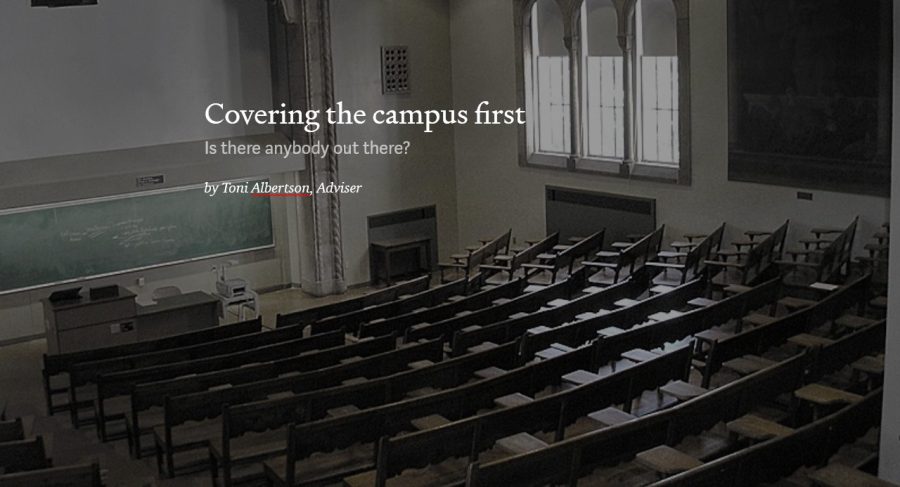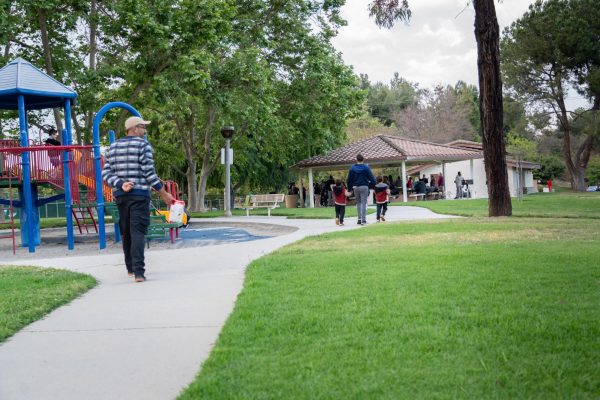Covering the campus first
Is there anybody out there?

We are in the third week of moving our newsroom over to Medium. The students are on a high but there have been a few obstacles. The great thing about obstacles is that it opens doorways to solutions.
When we entered into this partnership with Medium, we used Matter as the ultimate goal for what we hoped to achieve. There are some great benefits to using this model – it has made my students not only elevate their writing skills, but increase the depth of their stories. The downside is that it has caused them to hold back their stories until they feel they have achieved the highest level possible. To them, this means that the stories must reach the journalistic level of the stories on that publication.
And then reality set in. They are not the writers at Matter. They are young student journalists still learning to write well.
I asked Web Entrepreneur Andy Baio if he might meet with my students via Skype and share his decade plus experience of writing on the Web. This one meeting changed everything.
“At least 90 percent of what’s out there on the Web is crap. Odds are, some of your stuff will be crap. But at least you’re trying; you’re writing; creating; publishing. That’s a very brave thing. And you will get better, ” Andy said.
After that meeting, the students decided that it was time to let it go (cue soundtrack from Frozen). They made the decision to put out five stories, one per day, five a week, starting with week four. Even if the stories are not Pulitzer Prize-worthy, they are going to be published. And this meant coming to terms with the fact that they may not be writing on the level of the writers at Matter, or The Message, at least for now. But they certainly can strive to be that good…today, tomorrow, next year.
But there’s something else I’m trying to come to terms with: The importance of focusing on campus news. (I expect that any adviser reading this just let out a gasp). I took a poll of every student in every class I teach. This amounts to 176 students. I started with the question, “Do you care about campus news?” In each class, there were no more than three students who responded, “Yes.” I took it a step further. I asked those students who responded “Yes” what it was they cared about campus news. Each responded that they belonged to a community on campus: Associated Student Government, Sign Language Club, Honors Society, and so on. The rest said they had no interest in reading campus news.
So I posed the question, “What if a friend messaged you that a water main broke on campus and half the campus is flooded. What is the first step you would take to find out if your car or transportation is affected? Nearly all responded, “We’d check Twitter.” Not one student responded that they would go to our student media website. The few that did not respond Twitter said they would check the college website.
This brought up a discussion about campus news in general. We decided to poll non-journalism students on campus about our website and print newspaper. We asked if they read the print newspaper, and as in past surveys, very few said they read it. We also asked if they read the website and very few knew it existed. The next question was to ask what would make them want to go to the site to get their campus news. Nearly all responded that they have no interest in campus news.
Is it possible that community college students don’t care about campus-specific news or is that all college students don’t care about campus news? Community college students are attending college to move on…to a four-year university or to a career. They come and they go. If they have a vested interest in the college like serving as a student government representative or a student media staffer, they hang out on campus and care about campus news. But the majority of students are in a hurry to get to their jobs, their families, or home to study or sleep.
The idea of not covering campus news first goes against everything I’ve been told by my academic peers. “Your students must cover the campus first,” they say. While I respect these advisers, maybe it’s time to question this theory. Why must students always cover campus news first? We have a new marketing director on campus and a student of mine works as her student assistant. His job is to put out campus news and post on the campus’ social media platforms. All of those breaking stories such as road closures and parking thefts and high heat warnings are posted on the college website. Are we competing with the marketing department and Twitter? I have to ask this question when 95 percent of students are turning to Twitter for breaking campus news and the rest go to the college website. What purpose do we serve if no one is going to our site for campus-related news?
And please don’t think I’m advocating the marketing department as a replacement for campus news. I’m simply saying that those breaking news stories and campus-related stories are not bringing in readers. And we must look at readership.
The most views we ever garnered on our student news site were for a story written about Miss Mexico, a former Mt. SAC student. Harvey Levin and his TMZ staffers made fun of her for being a community college student. Our student cartoonist Adam Valenzuela tweeted a cartoon to Mr. Levin that said, “Those who can’t, TMZ.” This story brought in over 800 hits.

A TMZ story brought us the most hits we’ve ever had on our student media news site. In just 48 hours, our featured story on Substance about growing up gay in a Latino Machismo culture had 14,000 views. The three stories behind it have between 3,000 and 4,000 views. This means that while we might not be writing at the level of Matter, our stories matter.
Some may argue that perhaps the problem lies with the student journalists: that we are not doing a good job of reporting if no one is reading the print newspaper or the student news website. I would strongly disagree. I won’t brag about all the writing awards we’ve received over the years because there are plenty of fine journalists out there writing for print who aren’t grabbing readers either. I will say that as a college newspaper, we have uncovered all kinds of wrongdoing and controversy during my tenure as adviser. Take the story we ran last year about sexual harassment of female athletes in our athletics department. Several coaches were under investigation for sexual harassment of the girl’s soccer team. One coach was fired and one was forced to resign. Campus news at its best, right?

That story won us several First Place writing awards from a couple of top journalism organizations but brought in a small number of hits on our website and the print edition sat sadly on the news racks. It’s not like the story was buried in the newspaper. The front cover photo was a powerful one with the headline: Coaches Accused of Sexual Harassment. We polled students on campus about that issue. The majority said they didn’t pick it up because it did not concern them – they were not in athletics. What if we had published the story on Medium and covered in depth the issues facing women athletes and the harassment that occurs from male athletes and coaches. Would we have had better luck with readership? My feeling is yes.
There is no question that students must first learn to write basic news before they can take on the big stories. But must they publish in a print newspaper and must they stick to campus news first?
Teaching students to publish in print newspapers is like law students participating in a mock trial. It’s great practice, but it sure isn’t the real world of today.
So for now, we will continue to publish campus news on our website, mountiewire.com. I’ve come to view it as mock trial. My beginning newswriting students can learn what works and does not work for the web. They can post campus-related stories in Inverted Pyramid style and basic feature stories. They can play around with the things that will hopefully bring some readers to our site. They can produce multimedia and visuals, and they can learn how to write catchy headlines. They will learn how to promote their stories using social media like Twitter. And they will cover campus news. After all, it’s great practice.
But in the end, my feeling is that journalism students who stick to just covering campus news may find that they are writing to a non-existent audience. A story about the cost of war to this generation going out to a global audience may not be campus specific, but it might make college students question things, not only from our campus but also from a campus in the Ukraine. And isn’t that what journalism is really about? Engaging people in conversation, uncovering the truth, informing, entertaining, and holding people accountable?
As we move forward, the student staff will attempt to write stories on Substance that rise above the local and mundane, but some won’t. Some will be crap. And that’s okay. Hopefully at least 10 percent will be fabulous.
This is a series of documentation about the Mt. San Antonio College’s move to Medium







